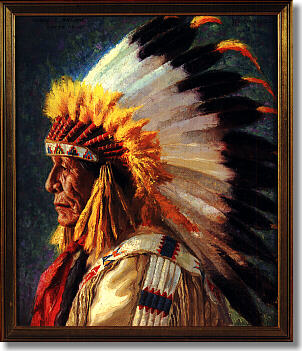Osage County, OK
 From early tribal tradition, and from the research of archaeologists and historians, and the ancestors of the Osage, we know that this tribe of Indians was closely affiliated with the Siouan, or Dhegiha tribes,
From early tribal tradition, and from the research of archaeologists and historians, and the ancestors of the Osage, we know that this tribe of Indians was closely affiliated with the Siouan, or Dhegiha tribes,their dialect being much the same.
The name, Osage, is a corruption of the tribal name, Wa-Zha-Zhe, that the Indians used themselves, the meaning and derivation is not clear.
The first recorded note of the Osage was by Marquette in 1673. His writing placed them on the Osage River in present Vernon County, Missouri, where they were still established, nearly 100 years later in 1759.
There is little known about the Osage from this time until the treaty at St. Louis in 1804. Here we find the explorers and French traders marrying into the Osage tribe. Almost from the beginning, trading with the Indians became a lucrative enterprise, for the white man and the spead of trade brought a large number of tribes into contact with the French, Spanish and English. All groups trying to make allies among the Indians.
The Osage signed their first treaty with the United States in 1808, ceding to the Federal Government lands new comprising over half the state of Missouri and northern Arkansas, including their old village located on the Little Osage River.
When the Osage signed the treaty of 1825 at St. Louis, they ceded all their lands to the United States, all of Oklahoma north of the Arkansas and Canadian Rivers, northwestern Arkansas, western Missouri and nearly half of Kansas.
Osage County today is the largest county in Oklahoma. Big Prairie? Imagine the vastness of 37,000 acres of prairie, disturbed only by the thunder of more than 800 bison. This is the Nature Conservancy's Tallgrass Prairie Preserve, lying just 17 mile north of Pawhuska. At one time, the American prairie spanned across fourteen states. Now, less than 10% of this original prairie remains, but the prairie surrounding Pawhuska is still flourishing. On the Tallgrass Prairie alone, over 600 plant, 300 bird, and 80 mammal species have been identified. Film teams from around the world have discovered the Tallgrass Prairie as a place of ecological richness and uncommon beauty.
Real Cowboys? Over 250,000 head of cattle thrive on the bluestem grass on over 1,000 ranches around the county. Numerous rodeos and ropings throughout the year give these real American cowboys the chance to showcase their immense skill to the public.
Explore Osage County
Battle of Chustenahlah Site
"This site, 3.5 miles NW is where Col. James McIntosh, 2nd ARK.MTD. Rifles, routed loyal Union Indian forces, December 26, 1861. The Battle opened with fire from the Indian line on Patriot's Hill, 2 miles SW. The loyal union Indians finally fled to Kansas." - Oklahoma Historical Society, 167-1995
Skiatook, OK BattlesitesOutdoor Sculptures
Cha' Tullis also has created several outstanding metal sculptures of Indians high atop Standpipe Hill in Hominy, as well as a handsome buffalo that stands next to the Gazebo on the Green downtown.
These concrete buffalo graze peacefully in a vacant lot along West Main.
Hominy, OK
Arts
Pawhuska Hospitality Center
The hospitality center was opened in August 1995. Volunteer hosts and hostesses offer visitors to Pawhuska a place to relax and learn information about the city of Pawhuska and surrounding communities. Snacks, souvenir items, and public restrooms are available on site. Tour busses welcome.
Pawhuska, OK Information CentersTriangle Building
This is a rare, free-standing triangle building. As early buildings in Pawhuska were constructed, a triangle-shaped piece of land was left in the middle of town. It was a park with a two-story bandstand in the center. In 1915, this five-story, "flat-iron"
Pawhuska, OK Historic BuildingsConstantine Community Center
The theater was originally built as the Pawhuska House Hotel in the 1880's. In 1911, Mr. C.C. Constantine purchased the building and remodeled it into the elegant Constantine Theater. In 1987, a group of concerned citizens began a long, tedious renovation. It is now over 90%
Pawhuska, OK Historic TheatresMarland Oils Building
Hominy's 1921 Marland service station is one of the few surviving examples of the popular triangle design utilized by the old Marland Oil Company (now Conoco). The building is under restoration by the Hominy Heritage Association.
Hominy, OK Historic Buildings
Historic Drummond Home
Fred Drummond moved to Hominy from Pawhuska to begin construction on his home and mercantile business in 1905. He and his family later expanded into cattle ranching. The home and its original furnishings were donated to the Oklahoma Historic Society in 1980
Hominy, OK MuseumsSkiatook Museum
At Skiatook Museum, anyone interested in their family tree or Skiatook's past, can view personal papers, documents, and photographs of the pioneer families, events and places, which are recorded here. In 1988
Skiatook, OK MuseumsImmaculate Conception Catholic Church
This church is known widely as the "Cathedral of the Osage". Special permission from the Vatican had to be granted to depict living tribal members in the glorious stained glass that was crafted in Munich, Germany in 1919
Pawhuska, OK Historic ChurchesOsage Indian Heritage
From early tribal tradition, and from the research of archaeologists and historians, and the ancestors of the Osage, we know that this tribe of Indians was closely affiliated with the Siouan, or Dhegiha tribes, their dialect being much the same.
Pawhuska, OK Ethnic HeritageBronze Sculptures
"Okie Cowboy"
"I spent much of my boyhood with a cowboy, the genuine article. This bronze sculpture reminds me of him, a man who had time for a boy." - Pawhuska Sculptor, John D. Free
A gift to the city of Pawhuska from Strat and Bobbie Tolson, 2000
112
Pawhuska, OK Arts